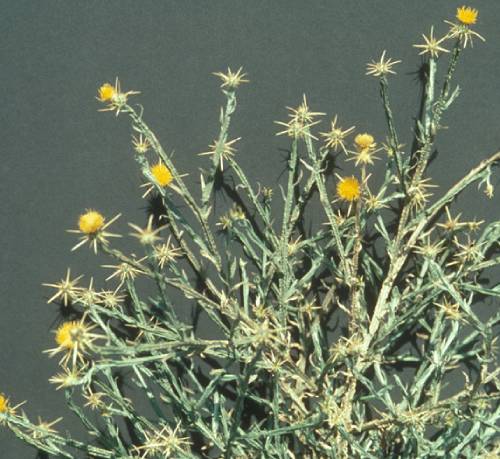Yellow starthistle identification and control
Information about the noxious weed yellow starthistle. Yellow starthistle is also known by its scientific name, Centaurea soltitialis.
About this weed
Yellow startthistle is a regulated Class B noxious weed. This means control is required state-wide.
Yellow starthistle is known as Centaurea soltitalis and is in the mustard family. Other common names include yellowcockspur and St. Baraby's thistle.

Why it's a noxious weed
Yellow starthistle can be harmful to livestock. Cattle feeding on yellow starthistle may be poorly nourished and can be damaged by the spiny heads. Horses feeding on it may be poisoned and can develop chewing disease.
Yellow starthistle is also very adaptable and can establish in nearly all semiarid or sub-humid rangeland.
Plant description
Yellow starthistle is an annual (one year life cycle) plant growing to a height of 18 to 36 inches.
During the vegetative stage it forms a rosette (a circular cluster of leaves at ground level) of non-spiny leaves, between 2–8 inches in diameter. Plants have deep taproots (long carrot-like roots). Stems have wings and are covered in thin, white, woolly hairs.
The flowerhead is wide and is made up of many yellow flowers. Petal like structures on the bottom of the flowerheads have spines of varying lengths. The notable large spines can be up to 3/4 of an inch long, yellowish in color and are star-like in arrangement.
There are two types of seeds, both are about 1/8th of an inch long and hairless. The outer seeds are dark brown and are without bristles. The inner seeds are glossy white, or light brown, and dotted with short, white bristles on one end.
Predominantly found in eastern Washington, yellow starthistle is an aggressive species that has invaded millions of acres of rangelands in the western United States. Yellow starthistle is found in rangeland, edges of cropland, abandoned farmlands and pastures as well as along roadsides, railways, and recreational areas.




Be aware of look-alike plants
Yellow star thistle can be mistaken for bighead knapweed and purple starthistle.
Yellow starthistle's basal and lower leaves are deeply lobed while the upper stem leaves are smaller, thin and pointed. The flowerheads are up to 1 inch and made up of small yellow flowers. The tip of the bract (modified leaf) has a straw colored spine that can be up to one inch long.
When in doubt, take photos and share them with us or report them on iNaturalist.
What to do if you find it
Please notify us if you see yellow starthistle growing in King County. Property owners are legally required to control yellow starthistle plants on their property.
We can provide the property owner or public agency with site-specific advice on how best to remove it. Also, because yellow starthistle is not established everywhere in King County, we can stop it from spreading if we act quickly. We map all known locations of regulated noxious weeds to help locate new infestations in time to control them.
Control methods
We recommend using a combination of methods to control noxious weeds. In areas with few weeds, it is important to act quickly before they become harder to control. Make a long-term plan as it often takes several years to get rid of most weeds. Start in the least infested areas first and then move into more heavily infested areas.
Manual control
This method is not feasible for large, dense infestations, but hand pulling can be very effective for small infestations. Monitoring and control are necessary for success with this method, and the area should be hand pulled frequently during the growing season as needed.
Cultural control
Good pasture management can help prevent or limit initial infestations. Plants need to be managed to prevent further seed production, and to promote desirable plants species in place of the yellow starthistle.
Biological control
There are several biological agents used on yellow starthistle. For further information about biological control agents for yellow starthistle, please visit Biocontrol Factsheets - NAISMA.
Chemical control
Stay safe when using herbicide:
- Always read the label before use.
- Wear a long-sleeved shirt, long pants, shoes, and eye protection.
- Follow state and local regulations.
2-4 D are both effective herbicide products for yellow starthistle in either cut stump or foliar applications. Treatment should be done in the late summer or early fall and follow the herbicide specimen label for specific use instructions.
For more information or a site-specific control recommendation in King County, contact the noxious weed program. For information in other counties in Washington state, contact your local weed or your local cooperative extension office.
Disposal instructions
Roots and stems of yellow starthistle can be composted, but all other plant parts, flowers, and seeds, should be bagged and disposed of in the garbage.
Noxious Weed Disposal - Washington State Noxious Weed Control Board

 Translate
Translate